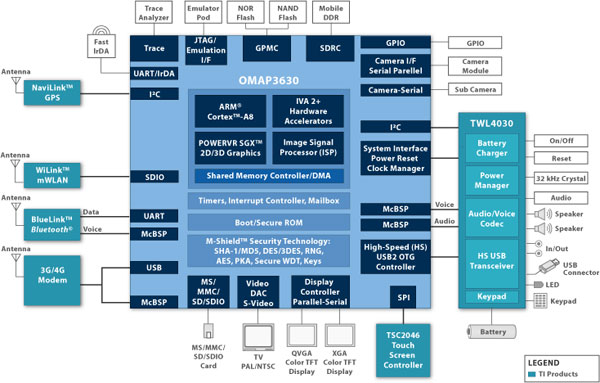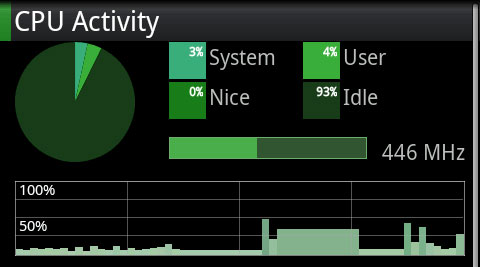Motorola Droid X: Thoroughly Reviewed
by Brian Klug on July 20, 2010 4:27 PM EST- Posted in
- Smartphones
- Motorola Droid X
- OMAP
- Mobile
Years ago, before we hit the power wall, CPU innovation happened at a slow but steady pace. Every five years or so we’d get a new microprocessor architecture and every couple of years we’d get smaller transistors.
The smaller transistors made chips run cooler and at higher clock speeds. The shrink in die area also paved the way for new features, but between major architectural shifts those features normally came in the form of larger caches.
Texas Instruments’ move from the OMAP 3430, used in phones like the Palm Pre, to the OMAP 3630 used in the Droid X is reminiscent of this sort of steady progress I mentioned above.
The OMAP 3430 was built on a 65nm process (like Qualcomm's Snapdragon), while the 3630 is a 45nm shrink (like Apple's A4). Architecturally the two SoCs are very similar. They both use a standard ARM Cortex A8 CPU paired with an Imagination Technologies PowerVR SGX 530 GPU. The two SoCs fit in the same size package (12mm x 12mm BGA) and are ball compatible. If a customer wanted to, it could simply drop in a 3630 into an existing 3430 design with minimal engineering efforts.
Note that the most direct competitor to the 3630 is Qualcomm’s Snapdragon. While TI uses a standard Cortex A8 core from ARM, Qualcomm designed its own low power ARMv7 based core that is similar, but not identical to the Cortex A8. Both are dual-issue, in-order architectures - they’re like the original Pentium, but in your phone. Qualcomm also integrated the cellular modem into the Snapdragon SoC while TI’s OMAP 3 is a strict application processor - the modem is housed in a separate chip.

On the CPU side TI doubled the L1 cache of the 3430 to 64KB (32KB instruction, 32KB data). The L2 cache remains unchanged at 256KB. We won’t get a larger L2 until the OMAP 4, which will ship with a 1MB L2 shared among its two cores. There are the usual tweaks and bug fixes which may improve performance per clock a little bit over the 3430, but overall the 3630 just gets a larger L1 as a result of the die shrink - oh and a much higher clock speed.
The Cortex A8 now runs at up to 1GHz. The OMAP 3430 topped out at 800MHz in shipping configurations but most vendors ran it at sub-600MHz speeds to save power. The 3630 in the Droid X runs at a full 1GHz. It's worth pointing out that Qualcomm was able to hit 1GHz on a similar architecture at 65nm by designing its core from the ground up. There's clearly value in these custom designs from a performance and time to market standpoint. These advantages will only become more critical as the SoC performance wars heat up.
Power Consumption
The OMAP 3 as well as Qualcomm’s Snapdragon SoC support dynamic voltage and frequency scaling. Based on application demand and cues from the OS the CPU clock speed and voltage can vary. The Cortex A8 in the OMAP 3630 will drop down to the low 300MHz range when idle at the Android home screen and ramp all the way up to 1GHz when needed.

TI's OMAP 3630 running at full tilt

...and automatically underclocked to 446MHz under lighter load
This is nothing unique to the OMAP 3630, but it shows that frequency and voltage scaling is alive and well in Android.
TI supports full power and clock gating. All major IP blocks are placed on their own power islands, so based on input from the OS the CPU, GPU, video decoder, etc... can ramp down depending on the application needs at the time. The power and clock gating is no more granular in the 3630 than it was in the 3430. What has changed however are operating voltages.
While the 3430 needed 1.35V to hit 720MHz, the 3630 can reach 1GHz at around 1.26V. That still sounds a bit high to me but at the same clock speed, thanks to voltage scaling, you can drop power by around 30% compared to the 3430.
Coupled with the dynamic voltage/frequency scaling of all OMAP 3 parts this means that overall power efficiency should be better on the 3630 vs. the 3430. The added CPU performance in the form of larger L1 caches and a higher clock speed should make tasks complete quicker and allow the 3630 to get to a lower voltage state than the 3430 was ever able to reach.
Samsung has already shown off 1.2GHz+ versions of its Cortex A8 based SoC at 45nm, so I would expect to see higher clocked versions of the 45nm OMAP 3 family to follow at some point in time.










89 Comments
View All Comments
Spoooon - Tuesday, July 27, 2010 - link
Just noticed some similarities between a "review" on CNN (http://money.cnn.com/galleries/2010/technology/100... and this one:CNN Money:
Overall, the build quality of the X is solid. Motorola has pulled off two high-end Android phones -- this and the original Droid -- that really feel good and inspire confidence. There's no give on any of the buttons, the volume buttons aren't loose and broken out of the box like some were on the original Droids, and the grippy plastic makes it feel even better. Having the phone tilt a few degrees and not rest completely flat on surfaces will help prevent the back from getting scratched up.
Anandtech:
Overall, the build quality of the X is solid. Motorola has pulled off two high end Android phones that really feel good and inspire a lot of confidence. There’s no give or play with any of the buttons, the volume buttons aren’t loose and broken out of the box like some Droids were, and the grippy plastic makes it feel even better. Again, I think having the phone tilt a few degrees and not rest completely flat on surfaces will help the back not get scratched up.
They are peppered throughout the CNN review. Maybe CNN borrowed your content with your consent?
Spoooon - Tuesday, July 27, 2010 - link
Oops. Noticed the attribution on the first page of the CNN article.LOL, I started reading it an hour ago, then stopped to work, then went back to it. :)
grkhetan - Thursday, July 29, 2010 - link
Hello, One question about the antenna chart. In the "holding naturally" column, where you touching the lower left black strip in the iphone 4?THanks
Gaurang.
brucebergman - Thursday, July 29, 2010 - link
I buy a phone to make phone calls first, be fancy second. (Fancy is nice, yes! But...) I didn't see anything on antenna analysis, or an externally accessible antenna jack should you feel the need to plug in some serious RF gain.My last two phones were the Audiovox CDM9000 and the LG VX2000, and currently is a Palm Treo 700wx. What do they have that the new crop do not? A real antenna, for those places where the NIMBY's won't allow new cell sites, and a way to connect an external antenna if you go out in the boonies a lot.
Until someone addresses this, I'm sticking with the Palm Treo. Or till it's hopelessly outdated and/or breaks and they can't find a replacement, at least.
weekilter - Thursday, July 29, 2010 - link
Too bad Moto couldn't have had the same understanding that Apple did and prevent VeriZon from putting their logos all over the device. Why the carriers think their logo adds to the appeal of a device is lost on me.myshadows - Monday, August 9, 2010 - link
Thanks for the awesome review! I may have missed this, but what is the speed of the internal 8 GB of memory compared to the Class 4 SD Card?ItsaRaid - Sunday, August 29, 2010 - link
Anand or Brian-Which would you pick?
Im trying to decide which way to go, I have a BB9700, with problems, I have looked at Both Phones the IPHone 4 and the Droid X- Im stuck- Hope maybe you can guide me as well.
Here is my Direct Contact Info:
ItsaRaid@columbus.rr.com
Hope you will take a few moments of time and help guide my decision making. Both Screens are Gorgeous and their sizes are no a big deal-
Thank You
Larry
BookDoctor - Monday, September 27, 2010 - link
I'm with you right down the line, especially regarding the length of the charging cord. Seems to me it's just another case of the supplier wanting to make an extra buck on accessories. Oh, well. . . . Nonetheless, I think the superior performance across the board makes it a small price to pay to have what's--at least in my book--the best Android device thus far.smithgood9 - Thursday, December 9, 2010 - link
As a Droid X fan, I find it useful to me. I wanted to transmit videos to PS3 for enjoying, but I failed. Because PS3 can only play it supports video formats. and PS3 can't support 3GP or other formats. Fortunately, I find a great Droid X video converter - Foxreal Video Converter, which can convert between various videos with excellent output quality. Use it transmit videos to MP4 and transmit videos to PS3 by DLNA function.